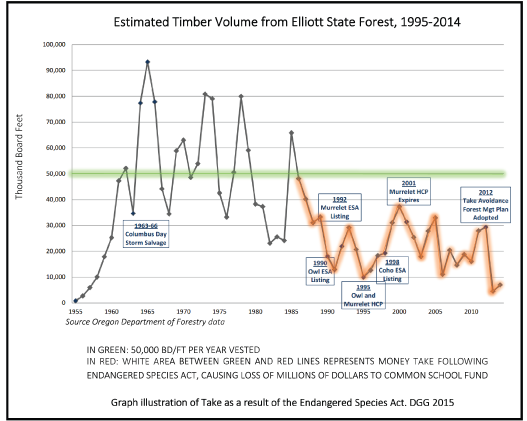By Margaret R. Bird
Background
In 1785 the Continental Congress granted one square mile (Section 16) in every 36 square mile township to support public schools.
The school grant was later expanded, and when Oregon joined the union in 1859 two sections, or 3.4 million acres were granted at statehood by Congress in trust to support public schools. (1)
Public schools are the beneficiaries, and the state of Oregon is the trustee. The lands and funds are overseen by the State Land Board comprised of the Governor, Secretary of State, and State Treasurer. (2)
The lands are administered by the Department of State Lands who pays the Oregon Department of Forestry to manage the Elliott Forest.
All proceeds from the granted lands are required by Constitution to be deposited in the Common School Fund. (3)
Oregon’s first Constitution as part of statehood indicated that the Common School Fund:
” . . . shall be set apart as a separate, and irreducible fund to be called the common school fund, for interest of which together with all other revenues derived from the school lands mentioned in this section shall be exclusively applied to the support, and maintenance of common schools in each school district and the purchase of suitable libraries, and apparatus therefor.”
Oregon First Constitution, Article VIII, Section 2
As of June 30, 2014, the fund was $1.45 billion. The proceeds from investing the fund support Oregon public schools.
In 1930, scattered school trust sections in the eastern portion of the state were exchanged with the federal government for 71,000 acres of burned timber lands in the Coast Range between Coos Bay and Reedsport. It was recognized that within a few decades, these lands could begin to generate timber revenue and that the well-managed forest would generate significant revenue as the trees re-grew. These lands are in one of the world’s most productive timber areas. It has been estimated that the Elliott Forest has an annual growth rate of 100 million board feet.

Endangered Species Act
Three threatened species live in the Elliott Forest. In 1990, the spotted owl was declared a threatened species by the U. S. Fish and Wildlife Service. In 1992, the marbled murrelet was declared a threatened species. In 1997, the Northern California Coho salmon was declared a threatened species in California but not in Oregon due to an Oregon Recovery Plan and better stream quality in Oregon.
In 1995 the U. S. Fish and Wildlife Service approved an Elliott State Forest Habitat Conservation Plan (HCP) that included a 60-year Incidental Take Permit for the owl and a 6-year Incidental Take Permit for the murrelet which expired for the murrelet in 2001. Since that time murrelets have been managed through a take-avoidance strategy.
The Oregon Department of State Lands was unwilling to accept conditions imposed by U.S. Fish and Game in an HCP on the murrelet.
Recent History of Management and Litigation
Harvesting of timber began in 1955 and by 1988 had a vested harvest of 50,000,000 board feet per year. After 1989, the timber sales averaged 23,000,000 board feet which has resulted in an estimated loss of about $230 million.
In October 2011, the State Land Board approved a Forest Management Plan that would have increased timber harvest to about 40 million board feet per year. This would generate about $28 million annually based on $694/thousand board feet (4) for Oregon’s Common School Fund, a fund to support future generations of school children.
In January 2012, Cascadia Wildlands, the Audubon Society of Portland, and the Center for Biological Diversity filed suit regarding habitat in state forests, including the Elliott, for the marbled murrelet, a seabird protected by the Endangered Species Act. The lawsuit halted or deferred some timber sales until it was settled in February 2014. The terms of the settlement of the case indefinitely scaled back timber harvest levels and associated revenues.
In FY 2013, the Department of State Lands lost $3 million for schools, as their expenditures to the Department of Forestry and their litigation costs exceeded their revenue by $3 million. This is the first time in 227 years of school trust history that a state has spent more than they have made from the school lands. This resulted in taking $3 million from the Oregon Common School Fund.
“Continued losses are projected into the future.”
ELLIOTT STATE FOREST, “An Asset of the Common School Fund,” Department of State Lands, revised June 2014, p.2.
A small volume of timber has been sold since the settlement and will be harvested before the end of 2016.

Oregon Land Board Decision to Sell
The Oregon State Land Board composed of the top elected officers of the state has now decided to sell 84,450 acres of school trust land in the Elliott Forest. Applicants may not pay one penny over the Department’s appraised value of $220.8 million; higher bids will be considered “non-responsive” and rejected. The list of potential buyers has already been closed with about 40 applicants including federal agencies, counties, State Department of Forestry, timber companies, native tribes, and conservation groups. Plans must be submitted by November 15, 2016, and the Oregon State Land Board will make their selection if more than one plan is submitted.
Transaction-Specific Protocol to Identify Potential Comprehensive Ownership Transferees for the Elliott Property, Oregon Department of State Lands.
“The plan must include commitments with enforceable mechanisms to protect enhanced public benefits above and beyond those which are already provided for under applicable federal, state, and local law, specifically (and at a minimum) including:”
- Conserving public recreational access on at least 50% of the acreage;
- Conserving the economic benefits from the Elliott Property by ensuring for a period totaling 10 years that at least 40 direct and indirect full-time jobs (or their equivalent) are generated annually from activities including timber harvest, hauling, reforestation, support of recreation activities, infrastructure maintenance, and habitat restoration;
- Conserving older forest stands by protecting from harvest at least 25% of the acreage; and
- Conserving high-quality watersheds by providing riparian management areas of 120 feet or more on both sides of all stream segments containing salmon, steelhead or bull trout and their transitional upstream reaches (to the next confluence, if the presence of these species does not end at a confluence); and
- The plan must be without any contingencies for the benefit of the transferee. “A responsive acquisition plan will need to identify other entities or agencies willing and able to enforce the commitments.” Any offer exceeding the appraised value of $220,800,000 by a penny will be considered “non-responsive.”
Fiduciary Duties of Oregon as Trustee
Pursuant to standard trust principles from Restatement of the Law on Trusts Sections 170-181 some of the state’s duties are:
References
- Oregon Enabling Act Section 4 and the Oregon Territorial Act of 1848, Section 20, August 14, 1848.
- Oregon Constitution, Article VIII, Section 5.
- Oregon Constitution, Article VIII, Section 2.
- Douglas Timber Operators, Timber Industry Report, January 31, 2016 for logs in southern Oregon



